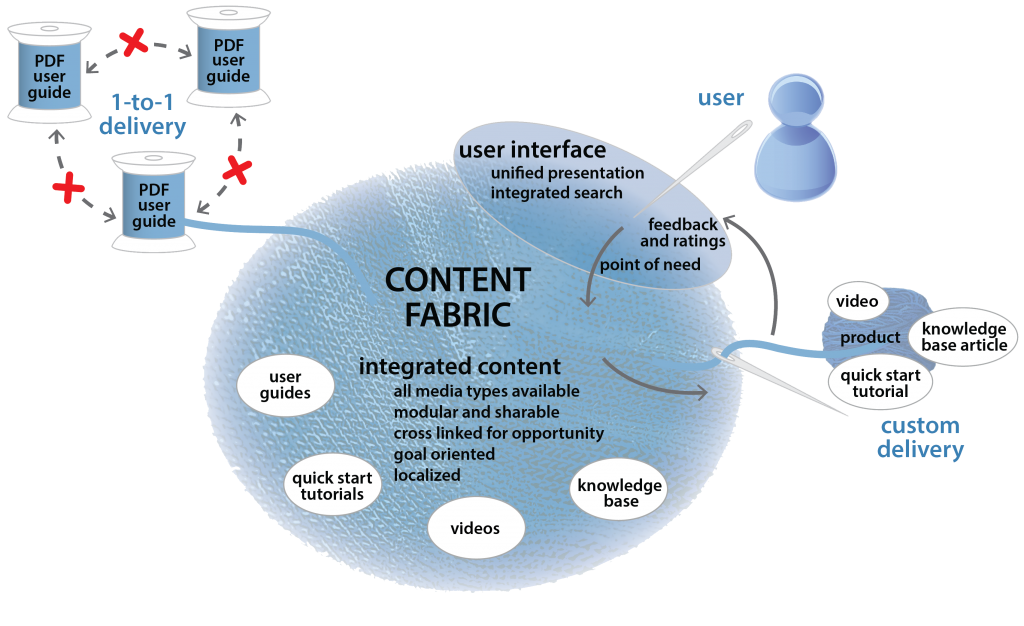Creating a unified customer experience with a content fabric
Coauthored by Anna Schlegel (Senior Director, Globalization and Information Engineering, NetApp) and Sarah O’Keefe (President, Scriptorium Publishing)
The interest in customer experience presents an opportunity for enterprise content strategists. You can use the customer experience angle to finally get content proposals and issues into the discussion. Ultimately, the challenge is in execution—once you raise awareness of the importance of content synchronization, you are expected to deliver on your promises. You must figure out how to deliver information that fits smoothly into the entire customer experience. At a minimum, that requires combining information from multiple departmental silos.
You need a customer experience that does not reproduce your organization’s internal structure. Customers need relevant, usable, and timely information—they don’t care that the video was developed by tech support and the how-to document by tech pubs. When customers search your web site, they want all relevant results, not just documents from a specific department. Furthermore, they assume you will use consistent terminology and will provide content in their preferred language. To meet these expectations, you need a unified content strategy.
At NetApp, the Information Engineering team uses the term content fabric to describe this unified approach. In the content fabric, customers get seamless delivery of the right information based on their needs. Multiple departments are involved in creating and delivering content. The processes are complex, but customers only see the end result. The content fabric aims to deliver information for each customer at the point of need.
Weaving a content fabric
To deliver a content fabric, you need the following key features:
- Search across all content sources
- Content in appropriate format(s)
- Content in appropriate languages
Each of these requirements expands into significant implementation challenges. To provide search across all content sources, for example, you have to solve the following issues:
-
- Provide search across more than a single deliverable (such as a PDF file)
- Provide search across all deliverables from one department for one product
- Provide search across all deliverables from all sources for one product
- Provide search across all deliverables from all sources for all products
- Align product classification schemes across the organization
- Align product terminology across the organization
- Align content localization across the organization
Several teams typically share responsibility for content development and delivery. You might have the following:
- Technical publications for technical communication
- Technical support for knowledge base
- IT for web site infrastructure
- Digital experience for web site architecture and appearance
- Marketing for technical white papers
- Training for job aids and e-learning
Each group has a different perspective on information, a different tool set, and a different set of expectations from their content creators. But somehow, you have to ensure that their content works in the big picture.
Unifying content organizations is important
Delivering a seamless content fabric means that different organizations must deliver compatible information. There are two main options to achieve this goal:
- Consolidate the content creators in a single organization
- Ensure that diverse content creators use the same content standards
Consolidation makes sense for similar roles. For example, most organizations put the entire technical communication function in a single team. Technical support and marketing have important content to contribute, but their functions and priorities differ from those of tech comm. In this case, the sensible approach is to share content infrastructure, including the following:
- Terminology and style guides. All content creators must use agreed-upon terminology to refer to the same thing. Everyone uses the same corporate style guide.
- Taxonomy. The classification system for content is shared across the organization. For example, the organization defines a set of categories, such as product name, release number, and content type, that label products and information.
- Content structure. A reference document always has the same structure, no matter who created it. Similarly, knowledge base articles always have the same structure across the organization.
- Content formatting. Content formatting matches corporate branding standards. All company content looks related, and all content of a particular type matches. For example, videos always include the company logo in the lower right corner, use the same types of visuals, and include standard introductions and conclusions. These formatting standards are enforced throughout the organization for all videos, not just in a single department.
- Search. All website content is searchable through a single search interface.
Connecting content development systems
The content fabric provides the reader with a single point of entry for information. This simple premise requires us to rethink how we develop and deliver information. The easiest way to deliver consistent information is to move all content creators into a single content development environment. Realistically, it’s more likely that you loosely connect multiple systems to produce a consistent end result. Challenges include different content development systems, taxonomies, search, and update cycles. Align these aspects to ensure that each content development pipeline delivers information that fits into the content fabric.
Adding translation to the mix
Globalization adds yet another layer of complexity to the content fabric. You must ensure that your unified delivery extends across all supported languages by making careful decisions about what, when, and how to translate. For example, if an organization wants to increase sales in South America, audit the content assets available in the local languages. Are you providing enough information? Is the content of high quality in the local language? Are you delivering Brazilian Portuguese (as opposed to Portuguese for Portugal) to Brazil? Is information being developed in the local languages or are you translating? If you are translating, what is your strategy for translation, localization, and transcreation?
The value of the content fabric
Why should organizations consider a content fabric like the one proposed at NetApp—a unified content strategy in which content efforts are carefully aligned across the enterprise? After all, it’s challenging to have consistency in a single department, let alone half a dozen groups across a far-flung organization.
The value of the content fabric is two-fold. First, you improve the customer experience. Instead of repeatedly transferring customers from one group to another, you provide the customer with a consistent, high-quality experience, in which questions are addressed in a single location. Second, you improve the overall content development process with less content redundancy and a single set of content development standards. In manufacturing terms, you are reducing waste and improving your quality control.
First steps toward your own content fabric
To begin the move toward your own content fabric, start with some basic questions:
- What information do you need to deliver and where?
- How is that information created and by whom?
- What standards are needed?
Once you understand the current environment, you can look at improving two major areas:
- Content development: Ensure that all content developers have the tools, technologies, and support they need to produce the right information.
- Content delivery: Ensure that information is presented to the customer in a unified interface.
Scriptorium and the Information Engineering team at NetApp are collaborating on NetApp’s journey to the content fabric.
This post is also available as a white paper, which you can read in PDF format.
Author: Anna Schlegel





Mary W
Great article! Any suggestions when you’re dealing with a massive, global organization that is struggling to overcome silos, with many egos who don’t want to “give up” the templates and styles they’ve created over the years and all think their way is the best?
Sarah O'Keefe
Hi Mary,
I have seen that maybe one or two (million) times. 🙂
The key is to avoid creating winners and losers. It’s not that everyone is going to use my Obviously Superior Templates. Instead, do an assessment of the organization’s needs and figure out the best approach. It’s often wise to create a new approach, so that everyone experiences some change and discomfort. (Or try the opposite…everyone keeps their existing workflow, but you find ways to align them so that the results at least seem related.)
Start with the overall assessment and figure out how your content will work best across the organization. Then work toward that goal.